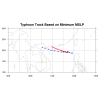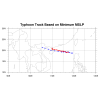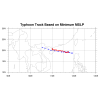Hello everyone,
I am running MPAS simulations to study typhoon tracks using different horizontal resolutions. I noticed something unexpected: When using quasi-uniform meshes with 15km and 24km resolution, the simulated typhoon tracks are much closer to the best track observations. However, when using a 60-3km variable resolution mesh, the simulated typhoon track deviates more from the observations.
For reference, I used the mesoscale reference physics suite and compared the MSLP fields. The result shows that the medium-resolution quasi-uniform meshes (15 km / 24 km) actually outperform the high-resolution variable-resolution mesh (60–3 km) in track prediction. I attached the typhoon track comparison plots here, and the blue line represents the observed values, while the red line represents the simulated values.
So I wonder to ask:
Why would medium-resolution quasi-uniform meshes produce better typhoon tracks than high-resolution variable-resolution meshes? Or could it be that it's due to the lack of coupling with the ocean model? Is MPAS suitable for simulating typhoons?
I am running MPAS simulations to study typhoon tracks using different horizontal resolutions. I noticed something unexpected: When using quasi-uniform meshes with 15km and 24km resolution, the simulated typhoon tracks are much closer to the best track observations. However, when using a 60-3km variable resolution mesh, the simulated typhoon track deviates more from the observations.
For reference, I used the mesoscale reference physics suite and compared the MSLP fields. The result shows that the medium-resolution quasi-uniform meshes (15 km / 24 km) actually outperform the high-resolution variable-resolution mesh (60–3 km) in track prediction. I attached the typhoon track comparison plots here, and the blue line represents the observed values, while the red line represents the simulated values.
So I wonder to ask:
Why would medium-resolution quasi-uniform meshes produce better typhoon tracks than high-resolution variable-resolution meshes? Or could it be that it's due to the lack of coupling with the ocean model? Is MPAS suitable for simulating typhoons?



